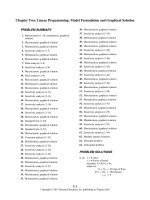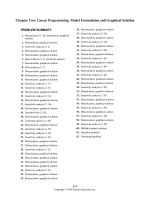Introduction to interdisciplinary studies 2nd edition by repko szostak buchberger test bank
Bạn đang xem bản rút gọn của tài liệu. Xem và tải ngay bản đầy đủ của tài liệu tại đây (372.81 KB, 8 trang )
Introduction to Interdisciplinary Studies 2nd edition by Allen F.
Repko, Rick Szostak, Michele Phillips Buchberger Test Bank
Link full download test bank: />
Chapter 2: The Rise of the Modern Disciplines and Interdisciplinarity
Level 1: Remembering or recalling factual information
1.
a.
b.
c.
The term “discipline” was introduced by the
Greeks
Persians
Romans
Ans: C
Learning Objective: LO 1
Answer Location: The Origin of the Concept of Disciplinarity
Question Type: MC
Difficulty Level: Easy
2. The revolution associated with an increased insistence on testing
theories through careful observation or experiment is the
a. Scientific revolution
b. Industrial revolution
c. Enlightened revolution
Ans: A
Learning Objective: LO 1
Answer Location: The Origin of the Concept of Disciplinarity
Question Type: MC
Difficulty Level: Easy
3. One of the reasons universities started to organize themselves around
the disciplines was
a. to effectively compete for resources
b. to attract more students
c. to make scheduling easier
Ans: A
Learning Objective: LO 1
Answer Location: The Professionalization of Knowledge
Question Type: MC
Difficulty Level: Easy
SAGE Publications, Inc. © 2017
1
Repko, Introduction to Interdisciplinary Studies 2
4. One cause of specialization in the sciences was
a. The need to focus journals in one area [or the need for journals to focus
on one area]
b. The increasing cost of instrumentation, elaborately equipped laboratories, and
highly trained personnel
c. The link between science and useful technology
Ans: B
Learning Objective: LO 1
Answer Location: The Professionalization of Knowledge
Question Type: MC
Difficulty Level: Easy
5.
a.
b.
c.
Specialization in the sciences was also affected by
An economy increasingly dependent upon scientific research
An economy increasingly dependent upon the disciplines
Interdisciplinarity
Ans: A
Learning Objective: LO 1
Answer Location: The Professionalization of Knowledge
Question Type: MC
Difficulty Level: Easy
6. The body of knowledge known as the humanities gained popularity as
they were called upon to
a. increase quantitative literacy
b. celebrate the inheritance of “Western Civilization” [or contributions]
c. increase knowledge of the scientific method
Ans: B
Learning Objective: LO 1
Answer Location: The Professionalization of Knowledge
Question Type: MC
Difficulty Level: Easy
A
7. By the end of the nineteenth century, disciplines can be characterized as:
a. Deciding what is taught, what is good research, by forming [delete:
the formation of] specialized journals, and deciding who gets hired and promoted
b. Selecting faculty, selecting students, and selecting curriculum
c. Deciding on when, where, and by whom particular topics will be taught
SAGE Publications, Inc. © 2017
2
Repko, Introduction to Interdisciplinary Studies 2
Ans: A
Learning Objective: LO 1
Answer Location: The Professionalization of Knowledge
Question Type: MC
Difficulty Level: Easy
8. The impulse toward specialization in the disciplines was welcomed by
everyone
a. True
b. False
Ans: False
Learning Objective: LO 1
Answer Location: Concerns About Overspecialization
Question Type: TF
Difficulty Level: Easy
9. Interdisciplinarity gained popularity as a response to the sense that the
intellectual tradition was becoming too
a. reductionist
b. specialized
c. both of the above
Ans: C
Learning Objective: LO 1
Answer Location: The Rise of Interdisciplinarity
Question Type: MC
Difficulty Level: Easy
10. The rise of interdisciplinarity began in the U.S. with
a. the reform of general education after Vietnam
b. the reform of general education after World War I
c. the reform of women’s education
Ans: B
Learning Objective: LO 2
Answer Location: The Quest for an Integrated Educational Experience
Question Type: MC
SAGE Publications, Inc. © 2017
3
Repko, Introduction to Interdisciplinary Studies 2
Difficulty Level: Easy
11. In the 1960s and 1970s in the U.S., a new set of reforms emerged
after calls for a new general education curriculum. This was prompted by
a. A need to provide a common core of knowledge, beliefs and values that would
help create a national identity to oppose Soviet totalitarianism and communist ideology
b. A need to reduce the deepening isolation of the disciplines from one another
c. A radical rejection of traditional education
d. All of the above
Ans: D
Learning Objective: LO 2
Answer Location: Interdisciplinarity in the 1960s and 1970s
Question Type: MC
Difficulty Level: Easy
12. The professional association that clarifies the name and practice of
interdisciplinarity is
a. The Association of Transdisciplinary Thought (ATT)
b. The Association of Interdisciplinary Studies (AIS)
c. The Association of Nonspecialisation (AN)
Ans: B
Learning Objective: LO 2
Answer Location: Interdisciplinarity Acquires Academic Legitimacy in the 1980s and 1990s
Question Type: MC
Difficulty Level: Easy
Level 2: Understanding key concepts and theories
13. The purpose of interdisciplinary studies is to
a. Develop your capacity to integrate and apply knowledge
b. Replace the disciplines.
c. Focus less on the university and more on the real world.
Ans: A
Learning Objective: LO 3
Answer Location: Interdisciplinarity’s Criticism of the Disciplines
Question Type: MC
Difficulty Level: Easy
SAGE Publications, Inc. © 2017
4
Repko, Introduction to Interdisciplinary Studies 2
14. Most interdisciplinarians believe that
a. Interdisciplinarity is a panacea for today’s problems
b. Disciplines and interdisciplinary studies working together might produce
creative breakthroughs that would otherwise not be possible using traditional
approaches.
c. Disciplinarity is the answer to today’s problems
Ans: B
Learning Objective: LO 3
Answer Location: Ch 2
Question Type: MC
Difficulty Level: Easy
15. The underlying premise of interdisciplinary studies is that
a. The disciplines are an obstacle to the progress of knowledge.
b. The disciplines are themselves the necessary foundation of the
interdisciplinary enterprise.
c. The disciplines should be replaced by multidisciplinary,
interdisciplinary, and transdisciplinary approaches.
Ans: B
Learning Objective: LO 2
Answer Location: Summary of the Interdisciplinary Criticism of Disciplinary Specialization
Question Type: MC
Difficulty Level: Easy
16. Interdisciplinarity recognizes that the disciplines are limited because
a. Specialism may make you less aware of the broader context of a situation
b. Specialism makes more likely to see connections between ideas
c. Specialism makes your more likely to answer theoretical but not practical
problems
Ans: A
Learning Objective: LO 3
Answer Location: Interdisciplinarity’s Criticism of the Disciplines
Question Type: MC
Difficulty Level: Easy
17. Specialization can hinder creative breakthroughs because
SAGE Publications, Inc. © 2017
5
Repko, Introduction to Interdisciplinary Studies 2
a. Creative breakthroughs often happen when unrelated ideas from
other disciplines are brought together
b. Specialists are naturally uncreative.
c. Interdisciplinarians focus on creative disciplines
Ans: A
Learning Objective: LO 3
Answer Location: Specialization Can Hinder Creative Breakthroughs
Question Type: MC
Difficulty Level: Easy
18. Complex problems benefit from interdisciplinary investigation because
a. Interdisciplinary research does not focus only on one component of the
problem
b. A truly comprehensive understanding draws on several
disciplinary contributions
c. Both of the above
Ans: C
Learning Objective: LO 3
Answer Location: Interdisciplinarity’s Criticism of the Disciplines
Question Type: MC
Difficulty Level: Easy
19. Specialization may not be the best way to deal with today’s problems
because
a. Today’s problems are increasingly complex and rapidly changing
b. Today’s problems need us to invent new disciplines to deal with
contemporary problems
c. Today’s problems are beyond the help of university disciplines
Ans: A
Learning Objective: LO 2
Answer Location: Interdisciplinarity’s Criticism of the Disciplines
Question Type: MC
Difficulty Level: Easy
20.
The relationship between interdisciplinarity and the disciplines is
SAGE Publications, Inc. © 2017
6
Repko, Introduction to Interdisciplinary Studies 2
a. Complementary. The disciplines are foundational to interdisciplinary work
b. Antagonistic. The disciplines are damaging to interdisciplinary work.
c. Irrelevant. The disciplines have no effect on interdisciplinary work.
Ans: A
Learning Objective: LO 3
Answer Location: Interdisciplinarity’s Criticism of the Disciplines
Question Type: MC
Difficulty Level: Easy
21. If you embark on interdisciplinary work
a. You do not need any disciplinary knowledge
b. You need to draw on disciplinary perspectives
c. You need to choose one discipline and choose only problems that fall within
its purview
Ans: B
Learning Objective: LO 3
Answer Location: Interdisciplinarity’s Criticism of the Disciplines
Question Type: MC
Difficulty Level: Easy
22. An advantage of interdisciplinary thinking is that
a. You don’t need to know details
b. You gain a more comprehensive understanding of complex problems
c. You can target your future career goals into one disciplinary silo
Ans: B
Learning Objective: LO 3
Answer Location: Interdisciplinarity’s Criticism of the Disciplines
Question Type: MC
Difficulty Level: Easy
Level 3: Applying concepts to specific situations that are hypothetical or real world
23. When examining the complex problem of Sex Discrimination in the
workplace
a. A disciplinary examination is sufficient.
SAGE Publications, Inc. © 2017
7
Repko, Introduction to Interdisciplinary Studies 2
b. An interdisciplinary approach would be beneficial because this problem
has facets that are the focus of more than one discipline
c. The discipline of sociology would be the best discipline to use
Ans: B
Learning Objective: LO 1, 2, 3
Answer Location: Ch 2
Question Type: MC
Difficulty Level: Easy
Level 4: Analyzing (a text or case or hypothetical situation to identify its parts and
explain its meaning)
24 . One of the primary objectives of Chapter 2 is to
a. Examine the rise and dominance of the disciplines over universities today
b. Examine why interdisciplinarity has gained prominence and popularity
in recent decades
c. Identify the flaws in interdisciplinary thinking
Ans: B
Learning Objective: LO 1, 2, 3
Answer Location: Ch 2
Question Type: MC
Difficulty Level: Easy
SAGE Publications, Inc. © 2017
8









